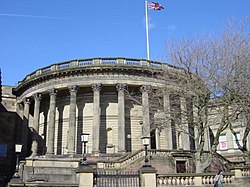53°24′35.50″N 02°58′49″W / 53.4098611°N 2.98028°W / 53.4098611; -2.98028
| This article needs additional citations for verification. Please help improve this article by adding citations to reliable sources. Unsourced material may be challenged and removed. Find sources: "Picton Reading Room and Hornby Library" – news · newspapers · books · scholar · JSTOR (December 2010) (Learn how and when to remove this message) |
| Picton Reading Room and Hornby Library | |
|---|---|
 Picton Reading Room, William Brown Street Picton Reading Room, William Brown Street | |
| General information | |
| Town or city | Liverpool |
| Country | England |
| Construction started | 1875 |
| Completed | 1906 |
| Design and construction | |
| Architect(s) | Cornelius Sherlock (Picton Reading Room) Thomas Shelmerdine (Hornby Library) |
The Picton Reading Room and Hornby Library are two grade II* listed buildings on William Brown Street, Liverpool, England, which now form part of the Liverpool Central Library.
The chairman of the William Brown Library and Museum, Sir James Picton, laid the foundation stone of the Picton Reading Room in 1875. It was designed by Cornelius Sherlock, and modelled after the British Museum Reading Room, and was the first electrically lit library in the UK. It was completed in 1879 formally opened by the Mayor of Liverpool, Sir Thomas Bland Royden. The front is semicircular with Corinthian columns, and the shape was chosen by the architect to cover the change in the axis of the row of buildings at this point. The Hornby Reading Room (named after Hugh Frederick Hornby) by Thomas Shelmerdine was added in 1906. It stands behind the older building and the interior is decorated in the Edwardian Imperial style.
Gallery
Picton Reading Room
-
 Bust of Sir James Picton
Bust of Sir James Picton
-
 View of the ground floor
View of the ground floor
-
 Seen from the gallery
Seen from the gallery
-
 Interior of the dome
Interior of the dome
-
 Doors to Hornby Library
Doors to Hornby Library
Hornby Library
-
 Bust of Hugh Frederick Hornby
Bust of Hugh Frederick Hornby
-
 Library interior
Library interior
-
 View from first floor gallery
View from first floor gallery
-
 The Oak Room, housing a copy of Audubon's The Birds of America
The Oak Room, housing a copy of Audubon's The Birds of America
See also
References
- Pevsner, N. (1969) Lancashire; 1: the industrial and commercial south. Harmondsworth: Penguin Books; p. 159
External links
This article about a Merseyside building or structure is a stub. You can help Misplaced Pages by expanding it. |